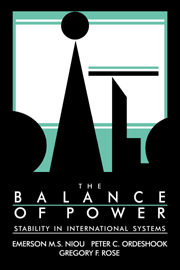Book contents
- Frontmatter
- Contents
- Acknowledgments
- 1 Introduction
- 2 Basic elements of a model and definitions of stability
- 3 System stability and the balance of power
- 4 Resource stability and the balance of power
- 5 Preventive war
- 6 Geography, balancers, and central powers
- 7 Great-power alliance formation, 1871–1914
- 8 European conflict resolution, 1875–1914
- 9 Summary and conclusions
- References and selected bibliography on European great-power relations, 1871–1914
- Index
2 - Basic elements of a model and definitions of stability
Published online by Cambridge University Press: 03 May 2010
- Frontmatter
- Contents
- Acknowledgments
- 1 Introduction
- 2 Basic elements of a model and definitions of stability
- 3 System stability and the balance of power
- 4 Resource stability and the balance of power
- 5 Preventive war
- 6 Geography, balancers, and central powers
- 7 Great-power alliance formation, 1871–1914
- 8 European conflict resolution, 1875–1914
- 9 Summary and conclusions
- References and selected bibliography on European great-power relations, 1871–1914
- Index
Summary
International relations continue to be a recurring struggle for wealth and power among independent actors in a state of anarchy.
Robert Gilpin, War and Change in World Politics (1981, p. 7)Classic balance-of-power theory can be interpreted as an hypothesis that in a more-than-two-Power world there are no non-autonomous causes of systemic change;… the purely political aspect of the system's powerpolitical process always tends to produce a stable equilibrium which can be upset, if at all, only by autonomous changes.
Arthur L. Burns, Of Powers and their Politics (1968, p. 249)The balance's underlying principle… was that all the nth disengaged powers would tend to intervene on the side that seemed in danger of losing any ongoing war, to ensure that such a loser was not eliminated from the system and absorbed into an emerging colossus.
George H. Quester, Offense and Defense in the International System (1977, p. 64)Preliminary assumptions
Our objective in this chapter is to elaborate our second scenario of resource competition and survival - a game wherein the only explicit rule defining its structure is that any player can overcome a weaker adversary - so that it more clearly constitutes a model of international conflict and alliances. At the same time, we want to render the concept of equilibrium, implicit in the preceding quotations, analytically precise so that the full implications of egoistic choice in anarchic systems can be uncovered. Before we proceed too far, though, we must be certain that this scenario can model a process as complex as the relations among sovereign states.
- Type
- Chapter
- Information
- The Balance of PowerStability in International Systems, pp. 36 - 74Publisher: Cambridge University PressPrint publication year: 1989



